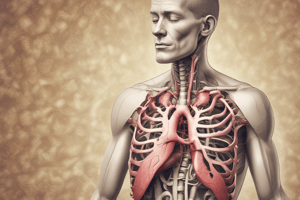Podcast
Questions and Answers
What is the primary mechanism of action for mast cell stabilizers in treating asthma?
What is the primary mechanism of action for mast cell stabilizers in treating asthma?
- Blocking the binding of acetylcholine to receptors in the airways
- Dilating bronchioles to improve airflow
- Suppressing inflammation by reducing leukotriene production
- Inhibiting the release of histamine from mast cells (correct)
Which of the following is a potential side effect of mast cell stabilizers when administered acutely?
Which of the following is a potential side effect of mast cell stabilizers when administered acutely?
- Increased risk of infection
- Bronchospasm (correct)
- Gastrointestinal upset
- Hepatotoxicity
What is the role of chloride ion conduction in the mechanism of action of mast cell stabilizers?
What is the role of chloride ion conduction in the mechanism of action of mast cell stabilizers?
- Increasing calcium influx, leading to mast cell degranulation
- Stabilizing the mast cell membrane, preventing degranulation (correct)
- Inhibiting the production of histamine by the mast cell
- Promoting the release of leukotrienes, amplifying the inflammatory response
Which of the following drugs is a lipoxygenase inhibitor used in the treatment of asthma?
Which of the following drugs is a lipoxygenase inhibitor used in the treatment of asthma?
What is the primary target of Zileuton in its mechanism of action?
What is the primary target of Zileuton in its mechanism of action?
Which of the following is a potential adverse effect associated with Zileuton?
Which of the following is a potential adverse effect associated with Zileuton?
What is the frequency of ALT monitoring recommended for patients on Zileuton therapy?
What is the frequency of ALT monitoring recommended for patients on Zileuton therapy?
Which of the following is NOT a common adverse effect of Zileuton?
Which of the following is NOT a common adverse effect of Zileuton?
What is the main difference between mast cell stabilizers and lipoxygenase inhibitors in their mechanism of action?
What is the main difference between mast cell stabilizers and lipoxygenase inhibitors in their mechanism of action?
Which of the following is an appropriate use for cromolyn sodium?
Which of the following is an appropriate use for cromolyn sodium?
What is the primary benefit of dextromethorphan?
What is the primary benefit of dextromethorphan?
What is the usual recommended adult daily dose of dextromethorphan?
What is the usual recommended adult daily dose of dextromethorphan?
What is a characteristic of dextromethorphan?
What is a characteristic of dextromethorphan?
What is a symptom of mild intoxication with dextromethorphan?
What is a symptom of mild intoxication with dextromethorphan?
What is the duration of effect of dextromethorphan?
What is the duration of effect of dextromethorphan?
What is a potential consequence of co-ingestion of dextromethorphan with alcohol?
What is a potential consequence of co-ingestion of dextromethorphan with alcohol?
What is the toxic dose of dextromethorphan in children?
What is the toxic dose of dextromethorphan in children?
What is a potential consequence of ingesting 20-30 mg/kg of dextromethorphan?
What is a potential consequence of ingesting 20-30 mg/kg of dextromethorphan?
What is a characteristic of the l-isomer of 3-methoxy-N-methylmorphinan?
What is a characteristic of the l-isomer of 3-methoxy-N-methylmorphinan?
What is dextromethorphan often found in combination with?
What is dextromethorphan often found in combination with?
What is the minimum number of times the therapeutic dose of pseudoephedrine that can cause symptoms?
What is the minimum number of times the therapeutic dose of pseudoephedrine that can cause symptoms?
What is the primary mechanism of action of PPA and phenylephrine?
What is the primary mechanism of action of PPA and phenylephrine?
Which group of patients may develop severe hypertension after subtherapeutic doses of sympathomimetic drugs?
Which group of patients may develop severe hypertension after subtherapeutic doses of sympathomimetic drugs?
What is a common use of phenylpropanolamine (PPA)?
What is a common use of phenylpropanolamine (PPA)?
What is a potential consequence of PPA use?
What is a potential consequence of PPA use?
What is a characteristic of PPA, phenylephrine, and ephedrine?
What is a characteristic of PPA, phenylephrine, and ephedrine?
What is the effect of dextromethorphan on N-methyl-D-aspartate (NMDA) glutamate receptors?
What is the effect of dextromethorphan on N-methyl-D-aspartate (NMDA) glutamate receptors?
What is a possible consequence of taking dextromethorphan with monoamine oxidase inhibitors?
What is a possible consequence of taking dextromethorphan with monoamine oxidase inhibitors?
What is the recommended treatment for dextromethorphan overdose?
What is the recommended treatment for dextromethorphan overdose?
What is the possible effect of dextromethorphan on serotonin levels?
What is the possible effect of dextromethorphan on serotonin levels?
What is a possible symptom of dextromethorphan overdose?
What is a possible symptom of dextromethorphan overdose?
What is the effect of dextromethorphan on neurotransmitters?
What is the effect of dextromethorphan on neurotransmitters?
What is the dose of naloxone that has been reported effective in treating dextromethorphan overdose?
What is the dose of naloxone that has been reported effective in treating dextromethorphan overdose?
What is a possible effect of dextromethorphan on mental status?
What is a possible effect of dextromethorphan on mental status?
What is the recommended treatment for hypertension in a patient with PPA overdose?
What is the recommended treatment for hypertension in a patient with PPA overdose?
What is the primary mechanism of toxicity for PPA overdose?
What is the primary mechanism of toxicity for PPA overdose?
Which of the following is a sign or symptom of PPA overdose?
Which of the following is a sign or symptom of PPA overdose?
What is the recommended approach to treating arrhythmias in a patient with PPA overdose?
What is the recommended approach to treating arrhythmias in a patient with PPA overdose?
Which of the following is NOT a recommended treatment for PPA overdose?
Which of the following is NOT a recommended treatment for PPA overdose?
What is the recommended approach to managing a patient with PPA overdose and associated bradycardia?
What is the recommended approach to managing a patient with PPA overdose and associated bradycardia?
What is the mechanism of action of PPA that contributes to its toxic effects?
What is the mechanism of action of PPA that contributes to its toxic effects?
What is the rationale for using urinary acidification in the management of PPA overdose?
What is the rationale for using urinary acidification in the management of PPA overdose?
What should be done before administering beta blockers to a patient with PPA overdose?
What should be done before administering beta blockers to a patient with PPA overdose?
What is the primary mechanism of action of PPA, contributing to its toxic effects?
What is the primary mechanism of action of PPA, contributing to its toxic effects?
What is the recommended treatment for hypertension in a patient with PPA overdose?
What is the recommended treatment for hypertension in a patient with PPA overdose?
What is a common sign or symptom of PPA overdose?
What is a common sign or symptom of PPA overdose?
Why is urinary acidification used in the management of PPA overdose?
Why is urinary acidification used in the management of PPA overdose?
What should be avoided when treating arrhythmias in a patient with PPA overdose?
What should be avoided when treating arrhythmias in a patient with PPA overdose?
What is the effect of dextromethorphan on N-methyl-D-aspartate (NMDA) glutamate receptors?
What is the effect of dextromethorphan on N-methyl-D-aspartate (NMDA) glutamate receptors?
What is the primary mechanism of toxicity of PPA?
What is the primary mechanism of toxicity of PPA?
What is a possible consequence of taking dextromethorphan with monoamine oxidase inhibitors?
What is a possible consequence of taking dextromethorphan with monoamine oxidase inhibitors?
What is the recommended approach to managing a patient with PPA overdose and associated bradycardia?
What is the recommended approach to managing a patient with PPA overdose and associated bradycardia?
What is the recommended treatment for dextromethorphan overdose?
What is the recommended treatment for dextromethorphan overdose?
What is the effect of dextromethorphan on serotonin levels?
What is the effect of dextromethorphan on serotonin levels?
What is a possible symptom of dextromethorphan overdose?
What is a possible symptom of dextromethorphan overdose?
What is the dose of naloxone that has been reported effective in treating dextromethorphan overdose?
What is the dose of naloxone that has been reported effective in treating dextromethorphan overdose?
What is the mechanism of toxicity of dextromethorphan?
What is the mechanism of toxicity of dextromethorphan?
What is the effect of dextromethorphan on mental status?
What is the effect of dextromethorphan on mental status?
What is the toxic dose of PPA after ingestion of therapeutic doses?
What is the toxic dose of PPA after ingestion of therapeutic doses?
Which of the following drugs acts as a direct alpha-adrenergic agonist?
Which of the following drugs acts as a direct alpha-adrenergic agonist?
What condition may arise in patients with autonomic insufficiency after taking sympathomimetic drugs?
What condition may arise in patients with autonomic insufficiency after taking sympathomimetic drugs?
What is a symptom that may indicate toxicity after ingesting pseudoephedrine?
What is a symptom that may indicate toxicity after ingesting pseudoephedrine?
What mechanism leads to toxicity in PPA overdose?
What mechanism leads to toxicity in PPA overdose?
Which of the following symptoms is NOT commonly associated with digitoxin toxicity?
Which of the following symptoms is NOT commonly associated with digitoxin toxicity?
Study Notes
Respiratory Drugs Overview
- Respiratory drugs include Dextromethorphan, PPA (Phenylpropanolamine), Theophylline, and Anti-inflammatory Agents.
Dextromethorphan
- Common ingredient in over-the-counter cough and cold medicines; recognized as a non-addictive opioid.
- Primarily functions as an antitussive (cough suppressant); found in products like Nyquil and Robitussin DM.
- Effective oral absorption; onset of effects within 15-30 minutes, with a duration of action of 3-6 hours.
- Toxicity generally occurs when doses exceed 10 mg/kg; symptoms can range from mild (clumsiness, hallucinations) to severe (stupor, respiratory depression).
- Contraindicated in cases of emesis (vomiting).
PPA & Related Decongestants
- PPA used as a nasal decongestant and appetite suppressant; can cause hemorrhagic stroke.
- Phenylephrine, Ephedrine, and Pseudoephedrine are common decongestants with sympathomimetic properties.
- Toxicity risks increase significantly with overdose; may lead to hypertensive crisis, confusion, and arrhythmias.
- Treatment includes vasodilators for hypertension, beta-blockers for arrhythmias, and careful monitoring in case of AV block or bradycardia.
- Urinary acidification can aid in elimination of toxic substances.
Anticholinergic/Antimuscarinic Bronchodilators
- Useful for COPD management; they include Ipratropium and Tiotropium.
- Mechanism: Block muscarinic receptors, which prevents contraction of airway smooth muscle.
- Side effects include tachycardia, constipation, and dry mouth.
Anti-inflammatory Agents
-
Mast Cell Stabilizers: Prevent degranulation of mast cells which would cause bronchoconstriction.
- Examples: Cromolyn sodium and Nedocromil; often used for allergic conditions and exercise-induced asthma.
- Side effects may include bronchospasm; pre-treatment with beta-agonists recommended.
-
Lipoxygenase Inhibitor: Zileuton inhibits leukotriene synthesis, helpful in managing inflammation in asthma.
- Side effects include hepatotoxicity; regular monitoring of liver enzymes (ALT) is necessary during use.
Rhabdomyolysis and Myoglobin Deposition
- Rapid breakdown of damaged skeletal muscle can lead to myoglobin deposition in the kidneys, potentially resulting in kidney damage.
Theophylline Overview
- Methylxanthine used primarily for asthma treatment, administered orally or via IV infusion (aminophylline) for conditions like bronchospasm and congestive heart failure.
- Commonly prescribed in sustained-release forms such as Theo-Dur and Theobid.
Clinical Presentation of Theophylline Toxicity
- Acute overdose symptoms include tremors, anxiety, tachycardia, and seizures when serum levels exceed 100 mg/L.
- Chronic intoxication manifests as vomiting, hypokalemia, hyperglycemia, and seizures at levels around 40-60 mg/L.
- Less common symptoms: hypophosphatemia, metabolic acidosis, and ventricular arrhythmias.
Mechanism of Toxicity
- High levels inhibit phosphodiesterase, increasing cyclic adenosine monophosphate (cAMP).
- Stimulates beta-adrenergic receptors specifically in the lungs.
- Acts as an adenosine receptor antagonist, promoting the release of endogenous catecholamines.
Treatment for Theophylline Toxicity
- Supportive emergency measures are essential for management.
- Low-dose propranolol (0.01-0.03 mg/kg IV) may counteract some cardiovascular effects.
Dextromethorphan Overview
- Found in many OTC cough and cold medications; an opioid derivative that lacks analgesic properties.
- Acts as an antitussive (cough suppressant) without addictive effects, commonly combined with antihistamines or decongestants.
Clinical Presentation of Dextromethorphan Toxicity
- Toxic symptoms appear when intake exceeds 10 mg/kg; mild intoxication can lead to clumsiness, ataxia, and hallucinations.
- Severe overdose may cause stupor, coma, respiratory depression (especially when combined with alcohol), and seizures from doses of 20-30 mg/kg.
Mechanism of Dextromethorphan Toxicity
- Antagonizes NMDA glutamate receptors, leading to altered mental status and psychoactive effects.
- Increases serotonin levels, potentially causing serotonin syndrome, particularly in patients on monoamine oxidase inhibitors (MAOIs).
Treatment for Dextromethorphan Toxicity
- Emergency measures including naloxone may be needed if there's suspicion of opioid intoxication, typically administering 0.4-2 mg IV with repeat doses as necessary.
- Activated charcoal can assist in decontamination for overdose situations.
Important Considerations
- Dextromethorphan has anticholinergic properties and is well-absorbed orally, with effects observed within 15-30 minutes and a duration of 3-6 hours.
- Pediatric dosing is considerably lower than adults, up to 30 mg/d for children aged 2-5 years.
Emesis and Phenylpropanolamine (PPA)
- PPA is an appetite suppressant linked to an increased risk of hemorrhagic stroke.
- Toxic doses can occur with 2-3 times the therapeutic dose for PPA, phenylephrine, and ephedrine.
- Pseudoephedrine toxicity symptoms may arise after 4-5 times the therapeutic dose.
- Common in nonprescription nasal decongestants and cold preparations, which often combine antihistamines and cough suppressants.
Mechanism of Action
- PPA and phenylephrine act as direct alpha-adrenergic agonists and have mild beta-adrenergic stimulation effects.
- PPA enhances norepinephrine release, contributing to its sympathomimetic activity.
- Ephedrine and pseudoephedrine exhibit both direct and indirect alpha- and beta-adrenergic activities, resulting in substantial beta-adrenergic stimulation compared to PPA or phenylephrine.
Clinical Presentation of Toxicity
- Major symptoms include:
- Hypertension due to alpha1-mediated vasoconstriction
- Headache and confusion
- Seizures and intracranial hemorrhage
- Bradycardia or AV block affecting electrical conduction in the heart
- Possible myocardial infarction
Treatment of Toxicity
- Emergency and supportive measures are critical.
- For hypertension with diastolic pressure > 100-105 mmHg, use vasodilators like phentolamine or nitroprusside.
- Do not administer beta blockers without prior vasodilator treatment; position patients upright.
- For arrhythmias, propranolol or esmolol may be given, but avoid beta blockers in bradycardia associated with hypertension.
- Ipecac-induced emesis, activated charcoal, and cathartics are used for decontamination.
- Urinary acidification enhances elimination for PPA, ephedrine, and pseudoephedrine.
Dextromethorphan and NMDA Receptor Inhibition
- Dextromethorphan and its metabolite inhibit NMDA glutamate receptors, leading to altered mental status and psychoactive effects.
- Inhibition of serotonin reuptake can lead to serotonin syndrome, characterized by confusion, agitation, tachycardia, hypertension, and mydriasis in patients using monoamine oxidase inhibitors.
Treatment for Serotonin Syndrome and Opioid Overdose
- Emergency and supportive measures are essential for serotonin syndrome cases.
- Naloxone is effective for opioid overdose; effective doses reported range from 0.06-0.4 mg, potentially requiring up to 2.4 mg if unresponsive.
- For signs of opioid intoxication, administer naloxone IV (0.4-2 mg) with repeat doses as necessary.
- Decontamination can also involve activated charcoal.
Emesis and Phenylpropanolamine (PPA)
- PPA is an appetite suppressant linked to an increased risk of hemorrhagic stroke.
- Toxic doses can occur with 2-3 times the therapeutic dose for PPA, phenylephrine, and ephedrine.
- Pseudoephedrine toxicity symptoms may arise after 4-5 times the therapeutic dose.
- Common in nonprescription nasal decongestants and cold preparations, which often combine antihistamines and cough suppressants.
Mechanism of Action
- PPA and phenylephrine act as direct alpha-adrenergic agonists and have mild beta-adrenergic stimulation effects.
- PPA enhances norepinephrine release, contributing to its sympathomimetic activity.
- Ephedrine and pseudoephedrine exhibit both direct and indirect alpha- and beta-adrenergic activities, resulting in substantial beta-adrenergic stimulation compared to PPA or phenylephrine.
Clinical Presentation of Toxicity
- Major symptoms include:
- Hypertension due to alpha1-mediated vasoconstriction
- Headache and confusion
- Seizures and intracranial hemorrhage
- Bradycardia or AV block affecting electrical conduction in the heart
- Possible myocardial infarction
Treatment of Toxicity
- Emergency and supportive measures are critical.
- For hypertension with diastolic pressure > 100-105 mmHg, use vasodilators like phentolamine or nitroprusside.
- Do not administer beta blockers without prior vasodilator treatment; position patients upright.
- For arrhythmias, propranolol or esmolol may be given, but avoid beta blockers in bradycardia associated with hypertension.
- Ipecac-induced emesis, activated charcoal, and cathartics are used for decontamination.
- Urinary acidification enhances elimination for PPA, ephedrine, and pseudoephedrine.
Dextromethorphan and NMDA Receptor Inhibition
- Dextromethorphan and its metabolite inhibit NMDA glutamate receptors, leading to altered mental status and psychoactive effects.
- Inhibition of serotonin reuptake can lead to serotonin syndrome, characterized by confusion, agitation, tachycardia, hypertension, and mydriasis in patients using monoamine oxidase inhibitors.
Treatment for Serotonin Syndrome and Opioid Overdose
- Emergency and supportive measures are essential for serotonin syndrome cases.
- Naloxone is effective for opioid overdose; effective doses reported range from 0.06-0.4 mg, potentially requiring up to 2.4 mg if unresponsive.
- For signs of opioid intoxication, administer naloxone IV (0.4-2 mg) with repeat doses as necessary.
- Decontamination can also involve activated charcoal.
Studying That Suits You
Use AI to generate personalized quizzes and flashcards to suit your learning preferences.
Related Documents
Description
Learn about various respiratory drugs, including Dextromethorphan, PPA, Theophylline, and Anti-inflammatory Agents. Understand their functions, effectiveness, and side effects.




